Structural and Transport Properties of E-Beam Sintered Lanthanide Tungstates and Tungstates-Molybdates
Abstract
:1. Introduction
2. Materials and Methods
3. Results and Discussion
3.1. Structure and Phase Composition
3.2. Morphological Characteristics
3.3. Proton Content and Conductivity
3.4. Oxygen Transport Characteristics
4. Conclusions
Author Contributions
Funding
Institutional Review Board Statement
Informed Consent Statement
Data Availability Statement
Conflicts of Interest
Nomenclature
| a | unit cell parameter (Å) or (nm); |
| D* | oxygen tracer diffusion coefficient (cm2 s−1); |
| f16–18 | C16O18O atomic fraction; |
| n(H+)/n(O2−) | molar ratio of the proton content to the oxygen; |
| T | temperature (°C) or (K); |
| V | unit cell volume (Å3); |
| Greek letters | |
| α | 18O atomic fraction; |
| 2θ | diffraction angle (°); |
| ρ | true density (g cm−3); |
| σH+ | protonic conductivity (Ω−1 cm−1). |
References
- Cheng, H. Dual-phase mixed protonic-electronic conducting hydrogen separation membranes: A review. Membranes 2022, 12, 647. [Google Scholar] [CrossRef] [PubMed]
- Shlyakhtina, A.V.; Lyskov, N.V.; Kolbanev, I.V.; Shchegolikhin, A.N.; Karyagina, O.K.; Shcherbakova, L.G. Key trends in the proton conductivity of Ln6−xMoO12−δ (Ln = La, Nd, Sm, Gd-Yb; x = 0, 0.5, 0.6, 0.7, 1) rare-earth molybdates. Int. J. Hydrogen Energy 2021, 46, 16989–16998. [Google Scholar] [CrossRef]
- Magrasó, A.; Haugsrud, R. Effects of the La/W ratio and doping on the structure, defect structure, stability and functional properties of proton-conducting lanthanum tungstate La28−xW4+xO54+δ. A review. J. Mater. Chem. A 2014, 2, 12630–12641. [Google Scholar] [CrossRef]
- Magrasó, A.; Polfus, J.M.; Frontera, C.; Canales-Vázquez, J.; Kalland, L.-E.; Hervoches, C.H.; Erdal, S.; Hancke, R.; Saiful Islam, M.; Norby, T.; et al. Complete structural model for lanthanum tungstate: A chemically stable high temperature proton conductor by means of intrinsic defects. J. Mater. Chem. 2012, 22, 1762–1764. [Google Scholar] [CrossRef]
- Shlyakhtina, A.V.; Savvin, S.N.; Lyskov, N.V.; Kolbanev, I.V.; Karyagina, O.K.; Chernyak, S.A.; Shcherbakova, L.G.; Núñez, P. Polymorphism in the family of Ln6−xMoO12−δ (Ln= La, Gd–Lu; x = 0, 0.5) oxygen ion- and proton-conducting materials. J. Mater. Chem. A 2017, 5, 7618–7630. [Google Scholar] [CrossRef]
- Sadykov, V.A.; Eremeev, N.F.; Fedorova, Y.E.; Krasnov, A.V.; Bobrova, L.N.; Bespalko, Y.N.; Lukashevich, A.I.; Skriabin, P.I.; Smorygo, O.L.; Van Veen, A.C. Design and performance of asymmetric supported membranes for oxygen and hydrogen separation. Int. J. Hydrogen Energy 2021, 46, 20222–20239. [Google Scholar] [CrossRef]
- Papac, M.; Stevanović, V.; Zakutayev, A.; O’Hayre, R. Triple ionic–electronic conducting oxides for next-generation electrochemical devices. Nat. Mater. 2021, 20, 301–313. [Google Scholar] [CrossRef]
- Escolástico, S.; Somacescu, S.; Serra, J.M. Tailoring mixed ionic–electronic conduction in H2 permeable membranes based on the system Nd5.5W1−xMoxO11.25−δ. J. Mater. Chem. A 2015, 3, 719–731. [Google Scholar] [CrossRef]
- Escolástico, S.; Solís, C.; Scherb, T.; Schumacher, G.; Serra, J.M. Hydrogen separation in La5.5WO11.25−δ membranes. J. Memb. Sci. 2013, 444, 276–284. [Google Scholar] [CrossRef]
- Escolástico, S.; Somacescu, S.; Serra, J.M. Solid state transport and hydrogen permeation in the system Nd5.5W1–xRexO11.25−δ. Chem. Mater. 2014, 2, 982–992. [Google Scholar] [CrossRef]
- Escolástico, S.; Serra, J.M. Nd5.5W1−xUxO11.25−δ system: Electrochemical characterization and hydrogen permeation study. J. Memb. Sci. 2015, 489, 112–118. [Google Scholar] [CrossRef]
- Escolástico, S.; Solís, C.; Haugsrud, R.; Magrasó, A.; Serra, J.M. On the ionic character of H2 separation through mixed conducting Nd5.5W0.5Mo0.5O11.25−δ membrane. Int. J. Hydrogen Energy 2017, 42, 11392–11399. [Google Scholar] [CrossRef]
- Liu, H.; Chen, Y.; Wei, Y.; Wang, H. CO2-tolerant U-shaped hollow fiber membranes for hydrogen separation. Int. J. Hydrogen Energy 2017, 42, 4208–4215. [Google Scholar] [CrossRef]
- Escolástico, S.; Shroeder, M.; Serra, J.M. Optimization of the mixed protonic–electronic conducting materials based on (Nd5/6Ln1/6)5.5WO11.25−δ. J. Mater. Chem. A 2014, 2, 6616–6630. [Google Scholar] [CrossRef]
- Shlyakhtina, A.V.; Avdeev, M.; Lyskov, N.V.; Abrantes, J.C.; Gomes, E.; Denisova, K.N.; Kolbanev, I.V.; Chernyak, S.A.; Volkova, O.S.; Vasiliev, A.N. Structure, conductivity and magnetism of orthorhombic and fluorite polymorphs in MoO3–Ln2O3 (Ln= Gd, Dy, Ho) systems. Dalton Trans. 2020, 49, 2833–2842. [Google Scholar] [CrossRef] [PubMed]
- Savvin, S.N.; Avdeev, M.; Kolbanev, I.V.; Kharitonova, E.P.; Shcherbakova, L.G.; Shlyakhtina, A.V.; Nuñez, P. Stability against reduction of fluorite-like rhombohedral La5.5MoO11.25 and Ho5.4Zr0.6MoO12.3 fluorite: Conductivity and neutron diffraction study. Solid State Ion. 2018, 319, 148–155. [Google Scholar] [CrossRef]
- Schildhammer, D.; Fuhrmann, G.; Petschnig, L.; Penner, S.; Kogler, M.; Götsch, T.; Schaur, A.; Weinberger, N.; Saxer, A.; Schottenberger, H.; et al. Synthetic access to cubic rare earth molybdenum oxides RE6MoO12−δ (RE= Tm–Lu) representing a new class of ion conductors. Chem. Mater. 2016, 28, 7487–7495. [Google Scholar] [CrossRef]
- Baidya, A.; Dutta, A. Structural, electrical, and dielectric properties of chemically derived Sm-doped cubic lanthanum molybdate nanomaterials. J. Phys. Chem. Solids 2021, 159, 110272. [Google Scholar] [CrossRef]
- Shlyakhtina, A.V.; Shcherbakova, L.G.; Savvin, S.N.; Núñez, P.; Knotko, A.V. Electrical conductivity of Ln6–xZrxMoO12+δ (Ln = La, Nd, Sm; x = 0.2, 0.6) ceramics during thermal cycling. Inorg. Mater. 2016, 52, 1055–1062. [Google Scholar] [CrossRef]
- Sadykov, V.; Usoltsev, V.; Fedorova, Y.; Mezentseva, N.; Krieger, T.; Eremeev, N.; Arapova, M.; Ishchenko, A.; Salanov, A.; Pelipenko, V.; et al. Advanced sintering techniques in design of planar IT SOFC and supported oxygen separation membranes. In Sintering of Ceramics—New Emerging Techniques; Lakshmanan, A., Ed.; InTech: Vienna, Austria, 2012; pp. 121–140. [Google Scholar] [CrossRef]
- Stary, O.; Malyshev, A.V.; Lysenko, E.N.; Petrova, A. Formation of magnetic properties of ferrites during radiation-thermal sintering. Euras. Phys. Tech. J. 2020, 17, 6–10. [Google Scholar] [CrossRef]
- Boldyrev, V.V.; Voronin, A.P.; Gribkov, O.S.; Tkachenko, E.V.; Karagedov, G.R.; Yakobson, B.I.; Auslender, V.L. Radiation-thermal synthesis. Current achievement and outlook. Solid State Ion. 1989, 36, 1–6. [Google Scholar] [CrossRef]
- Bespalko, Y.; Eremeev, N.; Skryabin, P.; Krieger, T.; Chesalov, Y.; Lapina, O.; Khabibulin, D.; Ulihin, A.; Uvarov, N.; Sadykov, V. Structural and transport properties of neodymium tungstates prepared via mechanochemical activation. Ceram. Int. 2019, 45, 9529–9536. [Google Scholar] [CrossRef]
- Eremeev, N.F.; Bespalko, Y.N.; Sadovskaya, E.M.; Skriabin, P.I.; Krieger, T.A.; Ishchenko, A.V.; Sadykov, V.A. Structural and transport properties of Nd tungstates and their composites with Ni0.5Cu0.5O obtained by mechanical activation. Dalton Trans. 2022, 51, 7705–7714. [Google Scholar] [CrossRef] [PubMed]
- Ancharova, U.; Mikhailenko, M.; Tolochko, B.; Lyakhov, N.; Korobeinikov, M.; Bryazgin, A.; Bezuglov, V.V.; Shtarklev, E.A.; Vlasov, A.Y.; Vinokurov, Z.S. Synthesis and staging of the phase formation for strontium ferrites in thermal and radiation-thermal reactions. IOP Conf. Ser. Mater. Sci. Eng. 2015, 81, 012122. [Google Scholar] [CrossRef]
- Scherb, T.; Fantin, A.; Checchia, S.; Stephan-Scherb, C.; Escolástico, S.; Franz, A.; Seeger, J.; Meulenberg, W.A.; d’Acapito, F.; Serra, J.M. Unravelling the crystal structure of Nd5.8WO12–δ and Nd5.7W0.75Mo0.25O12–δ mixed ionic electronic conductors. J. Appl. Cryst. 2020, 53, 1471–1483. [Google Scholar] [CrossRef]
- Rode, E.Y.; Karpov, V.N. Phase diagram of the system WO3-Nd2O3. Izv. Akad. Nauk SSSR Inorg. Mater. 1966, 2, 683–687. [Google Scholar]
- Yoshimura, M.; Yamaguchi, M.; Sōmiya, S. Reaction between Nd2O3 and WO3, and phase diagram of the system Nd2O3·2WO3-WO3. J. Ceram. Soc. JPN 1984, 8, 425–430. [Google Scholar] [CrossRef]
- Efremov, V.A. Characteristic features of the crystal chemistry of lanthanide molybdates and tungstates. Rus. Chem. Rev. 1990, 59, 627–642. [Google Scholar] [CrossRef]
- Yoshimura, M. X-ray characterization and thermal properties of 3R2O3·2WO3 compounds (R = La, Ce, Pr, and Nd). J. Am. Ceram. Soc. 1977, 60, 77–78. [Google Scholar] [CrossRef]
- Shannon, R.D. Revised effective ionic radii and systematic studies of interatomic distances in halides and chalcogenides. Acta Crystallogr. Sect. A 1976, 32, 751–767. [Google Scholar] [CrossRef]
- Annenkov, Y.M. Physical foundations for high-temperature electron-beam modification of ceramics. Russ. Phys. J. 1996, 39, 1146–1159. [Google Scholar] [CrossRef]
- Ancharova, U.V.; Mikhailenko, M.A.; Tolochko, B.P.; Lyakhov, N.Z.; Korobeinikov, M.V.; Bryazgin, A.A.; Vinokurov, Z.S.; Selyutin, A.G. Crystal phase structure investigation in the process of radiation-thermal transformations in systems SrO-Fe2O3, SrCO3-Fe2O3 (perovskite) and garnet Y2O3-Fe2O3. IOP Conf. Ser. Mater. Sci. Eng. 2016, 11, 012110. [Google Scholar] [CrossRef]
- Burdovitsin, V.; Dvilis, E.; Zenin, A.; Klimov, A.; Oks, E.; Sokolov, V.; Kachaev, A.A.; Khasanov, O.L. Electron beam sintering of zirconia ceramics. Adv. Mat. Res. 2014, 872, 150–156. [Google Scholar] [CrossRef]
- Colomban, P. Proton and protonic species: The hidden face of solid state chemistry. How to measure H-content in materials? Fuel Cells 2013, 13, 6–18. [Google Scholar] [CrossRef]
- Scherb, T. Strukturelle Charakterisierung von Wasserstoff Trennenden Gasseparationsmembranen auf Lanthanoid-Wolframat-Basis. Ph.D Dissertation, Technische Universität Berlin, Berlin, Germany, 2011. [Google Scholar] [CrossRef]
- Amsif, M.; Magrasó, A.; Marrero-López, D.; Ruiz-Morales, J.C.; Canales-Vázquez, J.; Núñez, P. Mo-substituted lanthanum tungstate La28–yW4+yO54+δ: A competitive mixed electron–proton conductor for gas separation membrane applications. Chem. Mater. 2012, 24, 3868–3877. [Google Scholar] [CrossRef]
- Ran, K.; Deibert, W.; Ivanova, M.E.; Meulenberg, W.A.; Mayer, J. Crystal structure investigation of La5.4W1−yMoyO12−δ for gas separation by high-resolution transmission electron microscopy. Sci. Rep. 2019, 9, 3274. [Google Scholar] [CrossRef]
- Ran, K.; Deibert, W.; Ivanova, M.E.; Meulenberg, W.A.; Mayer, J. Direction observation of the grain boundary segregation in molybdenum substituted lanthanum tungstate membranes. Nanoscale 2020, 12, 17841–17848. [Google Scholar] [CrossRef]
- Ran, K.; Deibert, W.; Du, H.; Park, D.; Ivanova, M.E.; Meulenberg, W.A.; Mayer, J. Processing-induced secondary phase formation in Mo-substituted lanthanum tungstate membranes. Acta Mater. 2019, 180, 35–41. [Google Scholar] [CrossRef]
- Gurauskis, J.; Gil, V.; Lin, B.; Einarsrud, M.-A. Pilot scale fabrication of lanthanum tungstate supports for H2 separation membranes. Open Ceram. 2022, 9, 100226. [Google Scholar] [CrossRef]

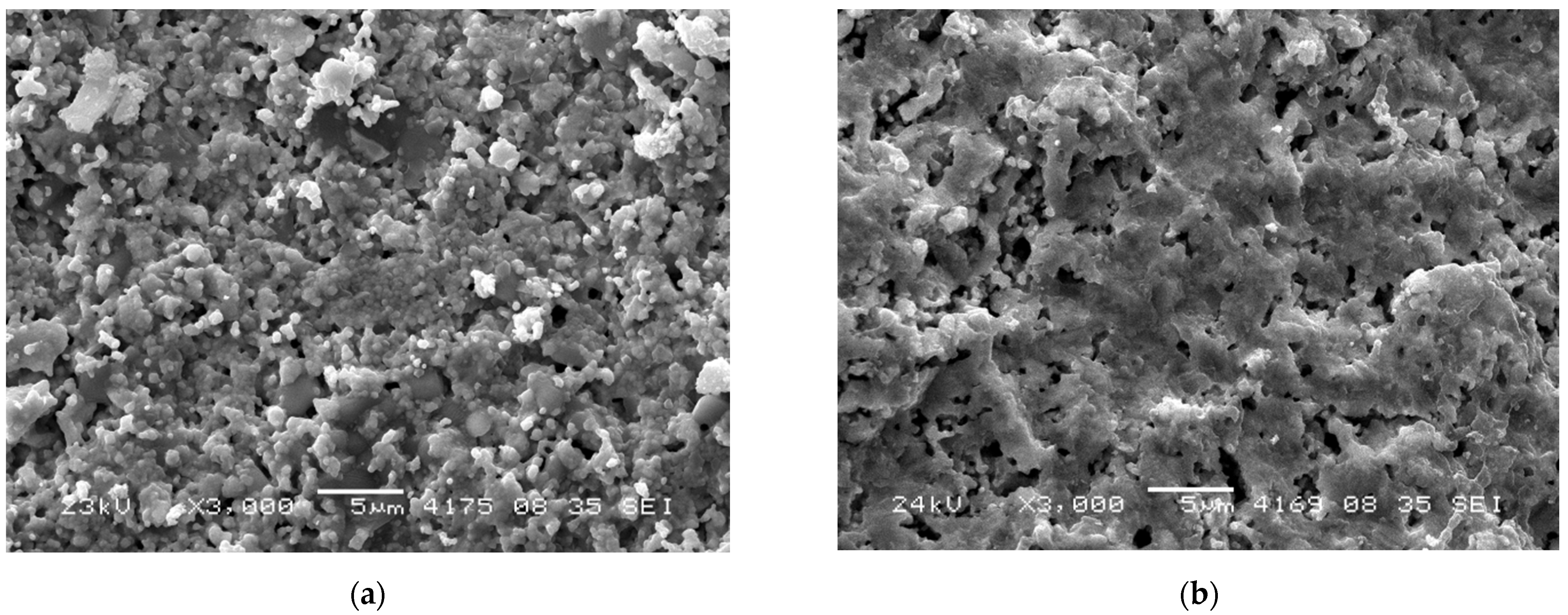
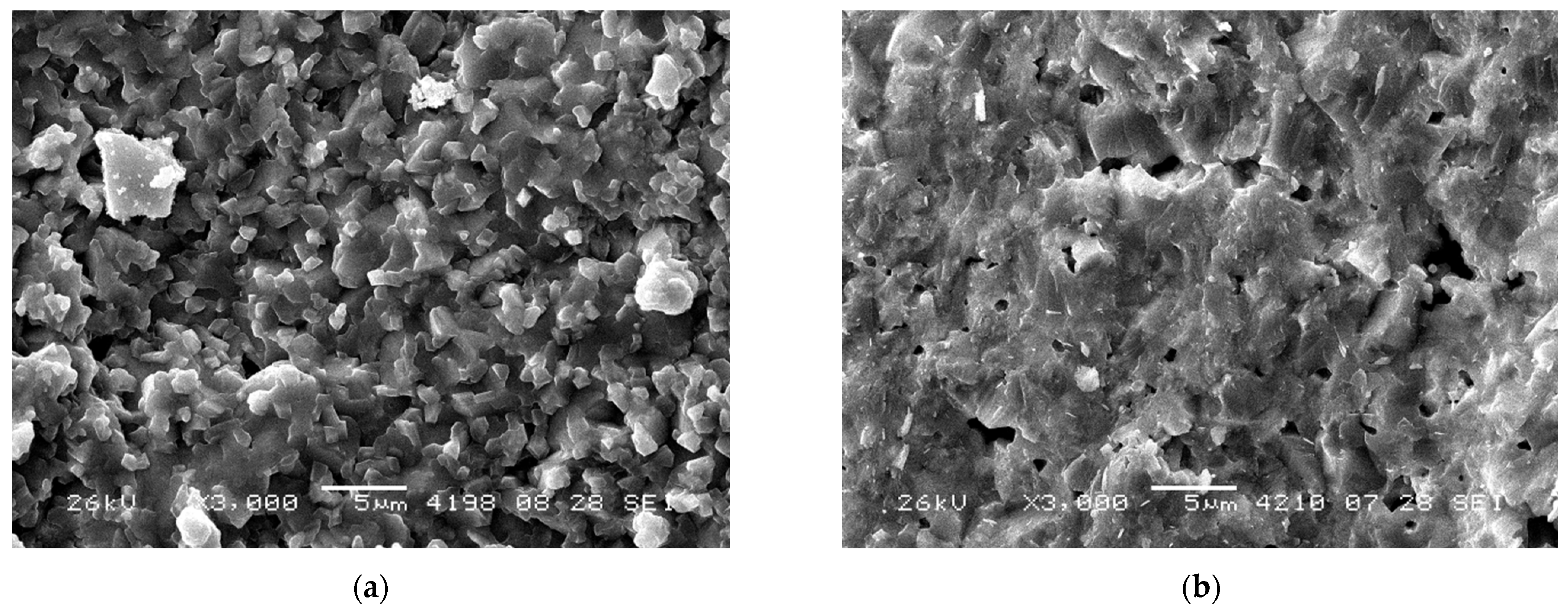
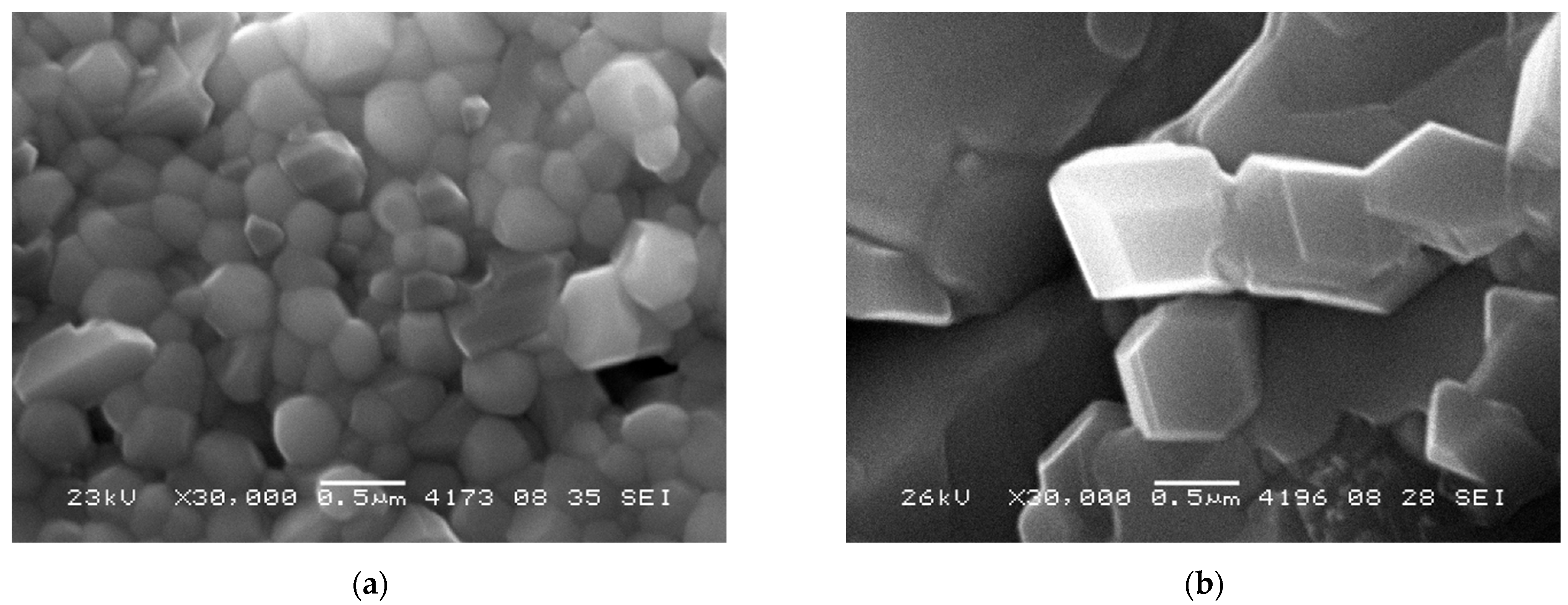
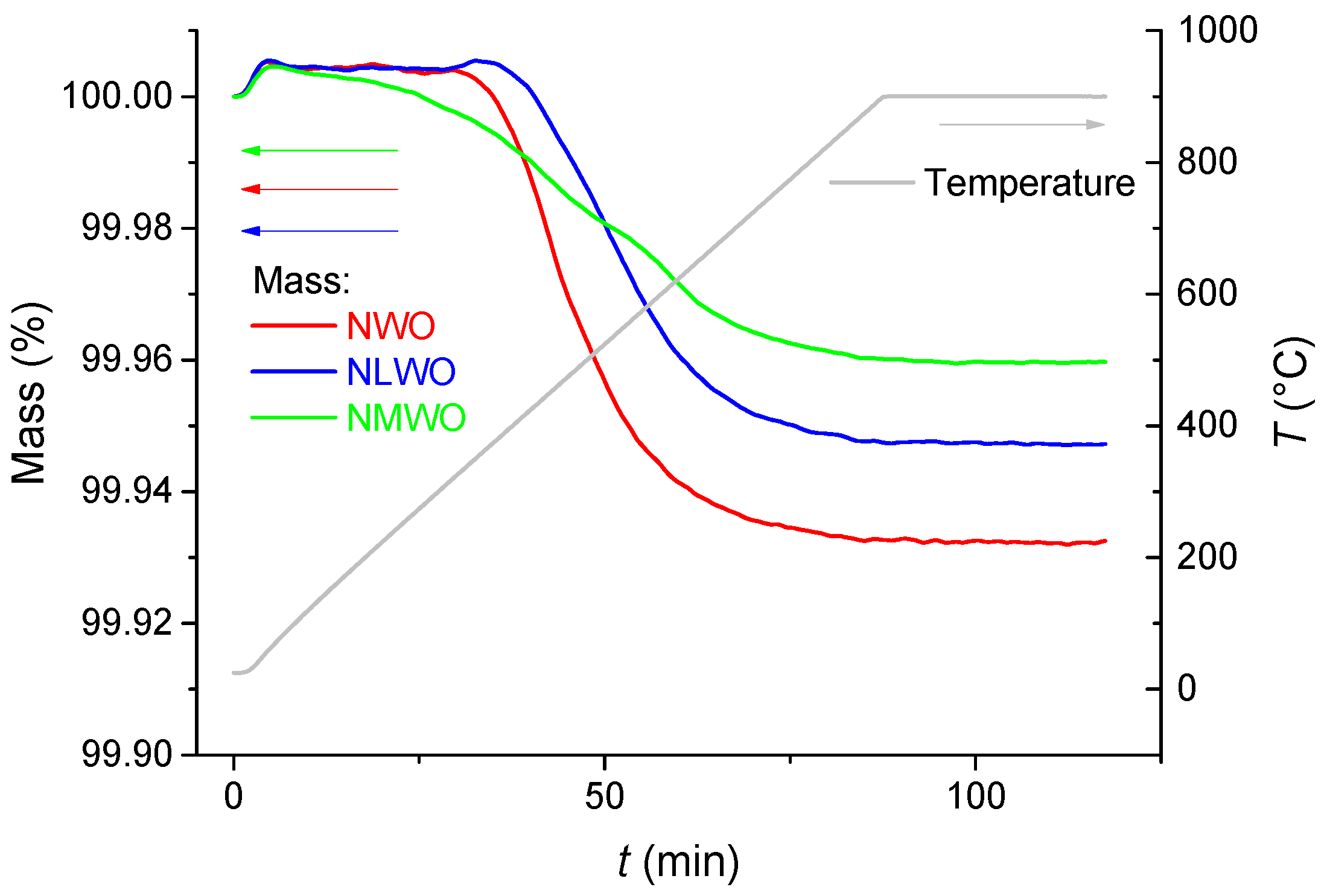

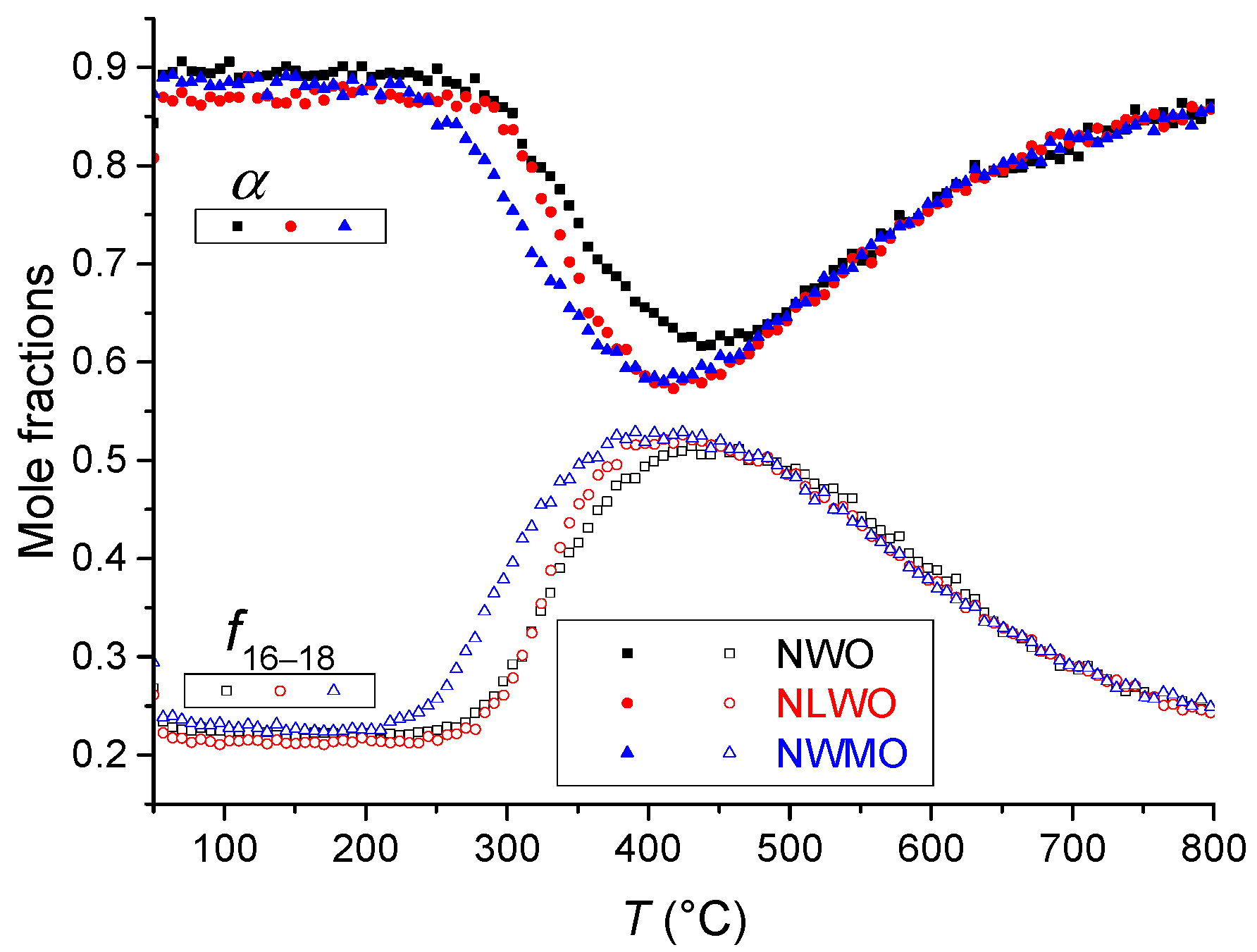
| Sample | Sintering Conditions | a (nm) | V (Å3) | ρ (g cm−3) | Reference |
|---|---|---|---|---|---|
| NWO | RTS, 1100 °C | 1.0930 | 1305.39 | 5.89 | This work |
| NWO | CS, 1100 °C | 1.093 | - | 5.89 | [23] |
| NWO | CS, 1300 °C | 1.0915 | - | 7.1 | [23] |
| NLWO | RTS, 1100 °C | 1.0985 | 1318.93 | 5.80 | This work |
| NLWO | CS, 1100 °C | 1.098 | - | 5.80 | [23] |
| NLWO | CS, 1300 °C | 1.0943 | - | 6.8 | [23] |
| NWMO | RTS, 1100 °C | 1.0934 | 1307.18 | 5.66 | This work |
| NWMO | CS, 1100 °C | 1.098 | - | 5.66 | [23] |
| NWMO | CS, 1300 °C | 1.0906 | - | 7.0 | [23] |
| Sample | Sintering Conditions | Particle Size (μm) | Relative Density (%) | Reference |
|---|---|---|---|---|
| NWO | RTS, 1100 °C | ~0.3 | 79 | This work |
| NWO | CS, 1100 °C | ~0.7 | [23] | |
| NWO | CS, 1300 °C | ~1 | 95 | [23] |
| NLWO | RTS, 1100 °C | 71 | This work | |
| NLWO | CS, 1100 °C | ~0.8 | [23] | |
| NLWO | CS, 1300 °C | ~1 | 92 | [23] |
| NWMO | RTS, 1100 °C | ~0.8 | 79 | This work |
| NWMO | CS, 1100 °C | ~0.9 | [23] | |
| NWMO | CS, 1300 °C | ~1 | 95 | [23] |
| Sample | n(H+)/n(O2−) |
|---|---|
| NWO | 0.00768 |
| NLWO | 0.00598 |
| NWMO | 0.00441 |
| Sample | Boundary Diffusion | Bulk Diffusion | ||
|---|---|---|---|---|
| Fast | Middle | Slow | ||
| NWO | 4.1 × 10−8 | 2.1 × 10−13 | 4.5 × 10−14 | 1.1 × 10−15 |
| NLWO | 5.7 × 10−8 | 7.1 × 10−14 | 1.6 × 10−14 | 3.8 × 10−16 |
| NWMO | 5.9 × 10−8 | 2.9 × 10−13 | 5.2 × 10−14 | 9.0 × 10−16 |
Publisher’s Note: MDPI stays neutral with regard to jurisdictional claims in published maps and institutional affiliations. |
© 2022 by the authors. Licensee MDPI, Basel, Switzerland. This article is an open access article distributed under the terms and conditions of the Creative Commons Attribution (CC BY) license (https://creativecommons.org/licenses/by/4.0/).
Share and Cite
Sadykov, V.; Bespalko, Y.; Sadovskaya, E.; Krieger, T.; Belyaev, V.; Eremeev, N.; Mikhailenko, M.; Bryazgin, A.; Korobeynikov, M.; Ulihin, A.; et al. Structural and Transport Properties of E-Beam Sintered Lanthanide Tungstates and Tungstates-Molybdates. Nanomaterials 2022, 12, 3282. https://doi.org/10.3390/nano12193282
Sadykov V, Bespalko Y, Sadovskaya E, Krieger T, Belyaev V, Eremeev N, Mikhailenko M, Bryazgin A, Korobeynikov M, Ulihin A, et al. Structural and Transport Properties of E-Beam Sintered Lanthanide Tungstates and Tungstates-Molybdates. Nanomaterials. 2022; 12(19):3282. https://doi.org/10.3390/nano12193282
Chicago/Turabian StyleSadykov, Vladislav, Yuliya Bespalko, Ekaterina Sadovskaya, Tamara Krieger, Vladimir Belyaev, Nikita Eremeev, Mikhail Mikhailenko, Alexander Bryazgin, Mikhail Korobeynikov, Artem Ulihin, and et al. 2022. "Structural and Transport Properties of E-Beam Sintered Lanthanide Tungstates and Tungstates-Molybdates" Nanomaterials 12, no. 19: 3282. https://doi.org/10.3390/nano12193282






